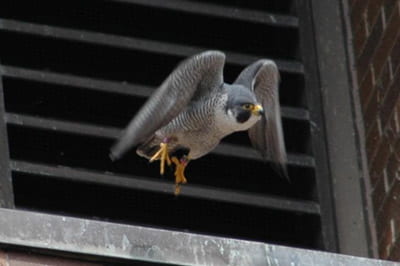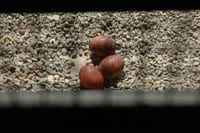Cofrin Library plays temporary host to pair of peregrine falcons
 The ubiquitous Phoenix may be the University of Wisconsin-Green Bay’s most familiar feathered friend, but earlier this spring it was a rare bird of another kind rising to notoriety on campus.
The ubiquitous Phoenix may be the University of Wisconsin-Green Bay’s most familiar feathered friend, but earlier this spring it was a rare bird of another kind rising to notoriety on campus.
At least two peregrine falcons made themselves at home on the roof of the eight-story Cofrin Library for about a month in April and into May, said Thomas Erdman, Richer Museum Curator at UW-Green Bay. Erdman and his fellow falcon watchers placed a box containing pea gravel on the roof to welcome the birds, which had discovered the location on their own. The female falcon laid three eggs and incubated for more than a week before something went awry, Erdman said.
“Something happened on the night or the very early morning of May 14 and 15 — Saturday and Sunday,” he said. “Everything was fine at dusk on the 14th, and at 6:30 (a.m.) on the 15th, there was a broken egg down below … on the bricks.”
Neither of the other eggs would survive, Erdman said, and with their failure the adult falcons more or less disappeared. Still, this is likely just the beginning, not the end, of the campus falcon story.
 First there is the mystery of just what happened to those eggs. And while no one can be certain, Erdman has a few theories about what went down in the wee hours of the night and early morning.
First there is the mystery of just what happened to those eggs. And while no one can be certain, Erdman has a few theories about what went down in the wee hours of the night and early morning.
It could be that youth and inexperience got the better of the two-year-old female — the birds are banded to identify characteristics including age — and she made some sort of clumsy mistake with her eggs, Erdman said. A great horned owl or crows could have scared the female bird or otherwise caused the calamity.
Finally, a third falcon had been spotted earlier — and if it was a female, Erdman said, it could have fought the other female bird. It’s possible the eggs were harmed in the melee.
“We don’t really know,” he said. “All we know is that the eggs got broken, and that was basically it for this year.”
But maybe not for good.
Erdman thinks it’s likely the falcons could return next spring, and he intends to be ready. The plan now is to put up a box during the winter — likely on the library, but possibly on the Weidner Center for the Performing Arts — and have it ready to go should the falcons return. From there, a camera could be set up to monitor the birds and the progress of any eggs.
“It’s neat to have them here,” Erdman said. “Our ex-Chancellor, Ed Weidner, would have been thrilled.”
 Peregrine falcons have fascinated scientists and citizens nationwide as efforts to restore this once-endangered species have gained notoriety. Their numbers once dwindled severely due to widespread use of DDT, which thinned eggshells and prevented chicks from hatching. Wisconsin was the first state to ban most uses of the chemical pesticide in 1969.
Peregrine falcons have fascinated scientists and citizens nationwide as efforts to restore this once-endangered species have gained notoriety. Their numbers once dwindled severely due to widespread use of DDT, which thinned eggshells and prevented chicks from hatching. Wisconsin was the first state to ban most uses of the chemical pesticide in 1969.
Peregrines have made a comeback, and in 2010 a total of 82 young were produced at 27 nesting sites in the state, according to the Wisconsin Falconwatch 2010 Nesting Season Report.
Locally, the Wisconsin Public Service Pulliam Power Plant is perhaps best known for hosting nesting falcons, which are monitored via Web cam. When chicks hatch, officials hold a contest to name them — this year’s falcons are Cliff and Champ. Green Bay’s Georgia-Pacific mill also is a nesting site.
The UW-Green Bay campus is ideal for peregrine falcons, Erdman said — close to the bay and there’s plenty of food for the predators. Falcons like to nest up high, so the Cofrin Library is a great place for them to be.
No one knows if the birds will be back, but there’s a good chance more of UW-Green Bay’s falcon story is yet to be written.
“When you work with wildlife, there’s always unexpected surprises,” Erdman said. “There are things that are beyond what you can do or predict.”



